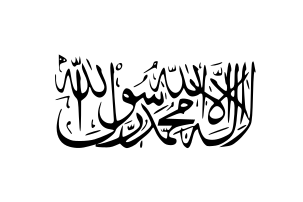The Army and Air Force of the Islamic Emirate of Afghanistan
| Army of the Islamic Emirate of Afghanistan | |
|---|---|
| الجيش والقوات الجوية لإمارة أفغانستان الإسلامية | |
 Flag of the Islamic Emirate of Afghanistan | |
| Founded | 1997 |
| Disbanded | 2001 |
| Service branches |
Army of the Islamic Emirate of Afghanistan Army Air Force of the Islamic Emirate of Afghanistan |
| Headquarters | Kabul |
| Manpower | |
| Military age | 15 |
| Conscription | Yes |
| Reaching military age annually | 200,000 (1998) |
| Active personnel | 1997-2001 |
| Reserve personnel | 15,000 |
| Industry | |
| Foreign suppliers |
|
The Army And Air Force of the Islamic Emirate of Afghanistan was the army and air force of the Islamic Emirate of Afghanistan.
Army
The Taliban maintained a military during their period of control. The Taliban army possessed over 400 T-54/55 and T-62 tanks and more than 200 armoured personnel carriers.[1] The Afghan Army inherited over 600 T-62 tanks.[2]
Air Force
The Afghan Air Force under the Taliban maintained five supersonic MIG-21MFs and 10 Sukhoi-22 fighter-bombers.[3] In 1995, during the 1995 Airstan incident, a Taliban fighter plane captured a Russian transport. They also held six Mil Mi-8 helicopters, five Mi-35s, five L-39Cs, six An-12s, 25 An-26s, a dozen An-24/32s, an IL-18, and a Yakovlev.[4] Their civil air service contained two Boeing 727A/Bs, a Tu-154, five An-24s, and a DHC-6.[4]
The Afghan Air Force under the Taliban did not see action in the Afghan Civil War and almost all aircraft wear destroyed by the US in the War in Afghanistan (2001–present). Most of the MiG-21 fleet met there end in an Afghan junkyard. The roundel of most of the aircraft was a washed over DRAAF Roundel with the green paint of the Taliban.[5][6]
1995 Airstan incident
On 3 August 1995 a Taliban Air Force MiG-21 aircraft forced the Russian aircraft to land at Kandahar.[7][8] Negotiations between the Russian government and the Taliban to free the men stalled for over a year and efforts by American senator Hank Brown to mediate between the two parties broke down over a prisoner exchange.[9] The Taliban stated that they would free the airmen if the Russians released Afghans held by the Russian government. However the Russians denied holding any Afghan citizens. Brown was able to get the Taliban to agree that the Russian crew should be allowed to maintain their aircraft.[9] This request paved the way for their escape.[9]
Inventory
| Aircraft | Origin | Type | Variant | In service | Notes | |
|---|---|---|---|---|---|---|
| Combat Aircraft | ||||||
| Mikoyan MiG-21 | Soviet Union | Fighter | Mikoyan MiG-21MF | 5 | ||
| Sukhoi Su-22 | Soviet Union | Attack | 10 | |||
| Transport | ||||||
| Antonov An-26 | Soviet Union | Transport | 25 | |||
| Antonov An-12 | Soviet Union | Transport | 6 | |||
| Antonov An-24/32 | Soviet Union | Transport | 12 | |||
| Ilyushin Il-18 | Soviet Union | Transport | 1 | |||
| Yakovlev Yak-40 | Soviet Union | VIP | 1 | |||
| Boeing 727 | United States | Passenger | Boeing 727A/B | 2 | ||
| Tupolev Tu-154 | United States | Passenger | 1 | |||
| De Havilland DHC-6 Twin Otter | Canada | Passenger | 1 | |||
| Helicopters | ||||||
| Mil Mi-35 | Soviet Union | Attack | 5 | |||
| Mil Mi-8 | Soviet Union | Transport | 6 | |||
| Trainer Aircraft | ||||||
| Aero L-39 | Czechoslovakia | Light Attack | L-39C | 5 | ||
Conscription
According to the testimony of Guantanamo captives before their Combatant Status Review Tribunals, the Taliban, in addition to conscripting men to serve as soldiers, also conscripted men to staff its civil service.[10]
Kidnapping foreigners
Prior to the collapse of their regime the Taliban made widespread use of conscription, and according to some of the Guantanamo captives, kidnapping and virtual slavery.
Conscription of children
According to a report from Oxford University the Taliban made widespread use of the conscription of children in 1997, 1998 and 1999.[11] The report states that during the civil war that preceded the Taliban regime thousands of orphaned boys joined various militia for "employment, food, shelter, protection and economic opportunity." The report said that during its initial period the Taliban "long depended upon cohorts of youth". Witnesses stated that each land-owning family had to provide one young man and $500 in expenses. In August of that year 5000 students aged between 15 and 35 left madrassas in Pakistan to join the Taliban.
References
- ↑ The Guardian, Taliban lose grip on Mazar i Sharif, 7 November 2001
- ↑ Stars and Stripes (2014-07-15), The Beasts of Kabul: Inside the Afghan Army's Soviet Tanks, retrieved 2018-07-05
- ↑ York, Geoffrey. The Globe and Mail, "Military Targets Are Elusive. Afghanistan Army Called a Haphazard Operation", 19 September 2001
- 1 2 Jane's Sentinel Security Assessment, 2001
- ↑ Ivanov, Grigory. "WINGS PALETTE - MiG MiG-21/J-7 Fishbed/Mongol - Afghanistan (Taliban)". wp.scn.ru. Retrieved 2018-07-05.
- ↑ Little is known about the Taliban regime's air force establishment.
- ↑ Reeves 1996
- ↑ Farah & Braun 2007, p. 60
- 1 2 3 Associated Press 1996, p. 4
- ↑ Dixon, Robyn (13 October 2001). "Afghans in Kabul Flee Taliban, Not U.S. Raids". Los Angeles Times. Retrieved 11 December 2012.
- ↑ Jo Boyden, Jo de Berry, Thomas Feeny, Jason Hart (January 2002). "Children Affected by Armed Conflict in South Asia: A review of trends and issues identified through secondary research" (PDF). University of Oxford Refugee Studies Centre. Archived from the original (PDF) on 2007-07-28. Retrieved 2008-01-05.